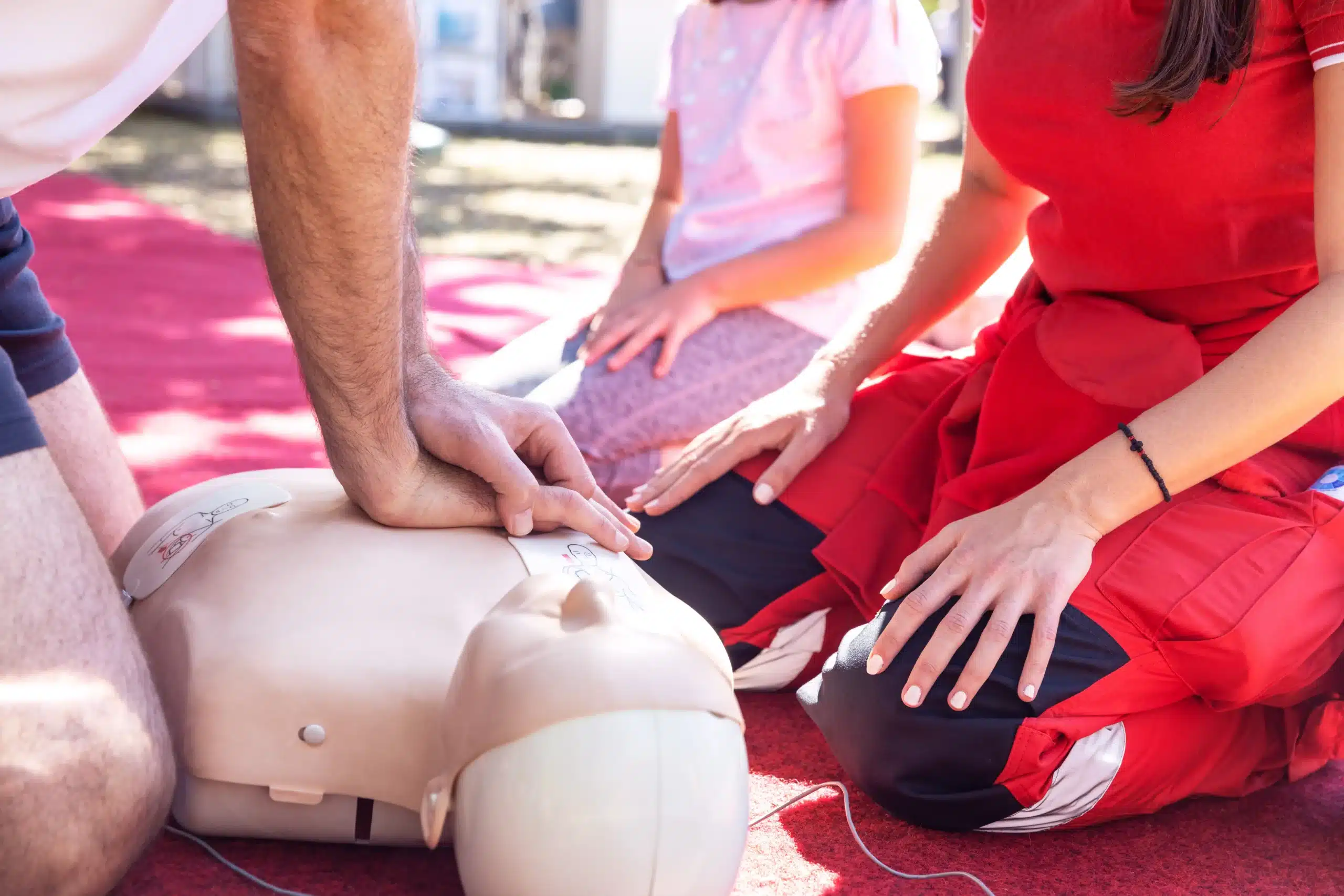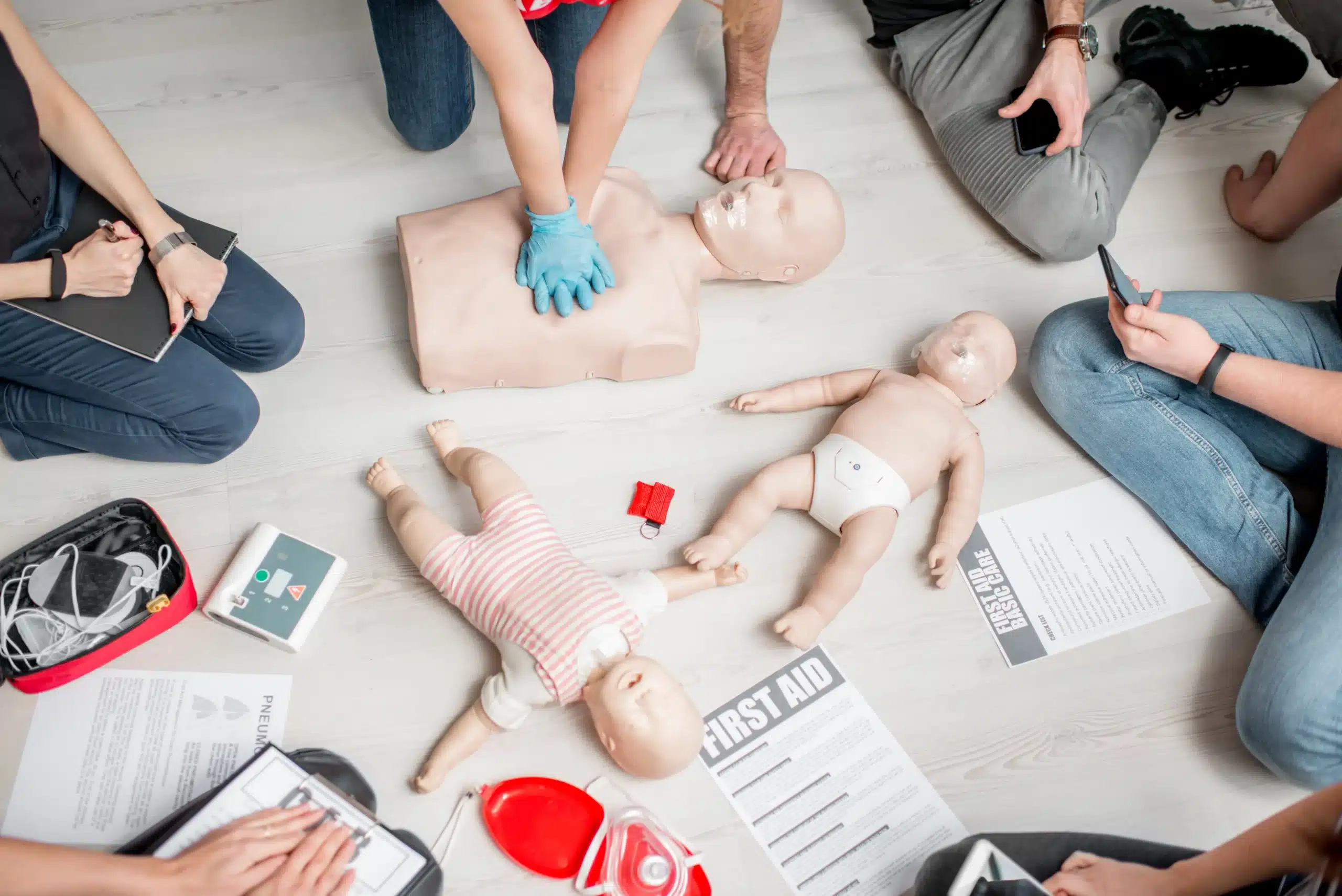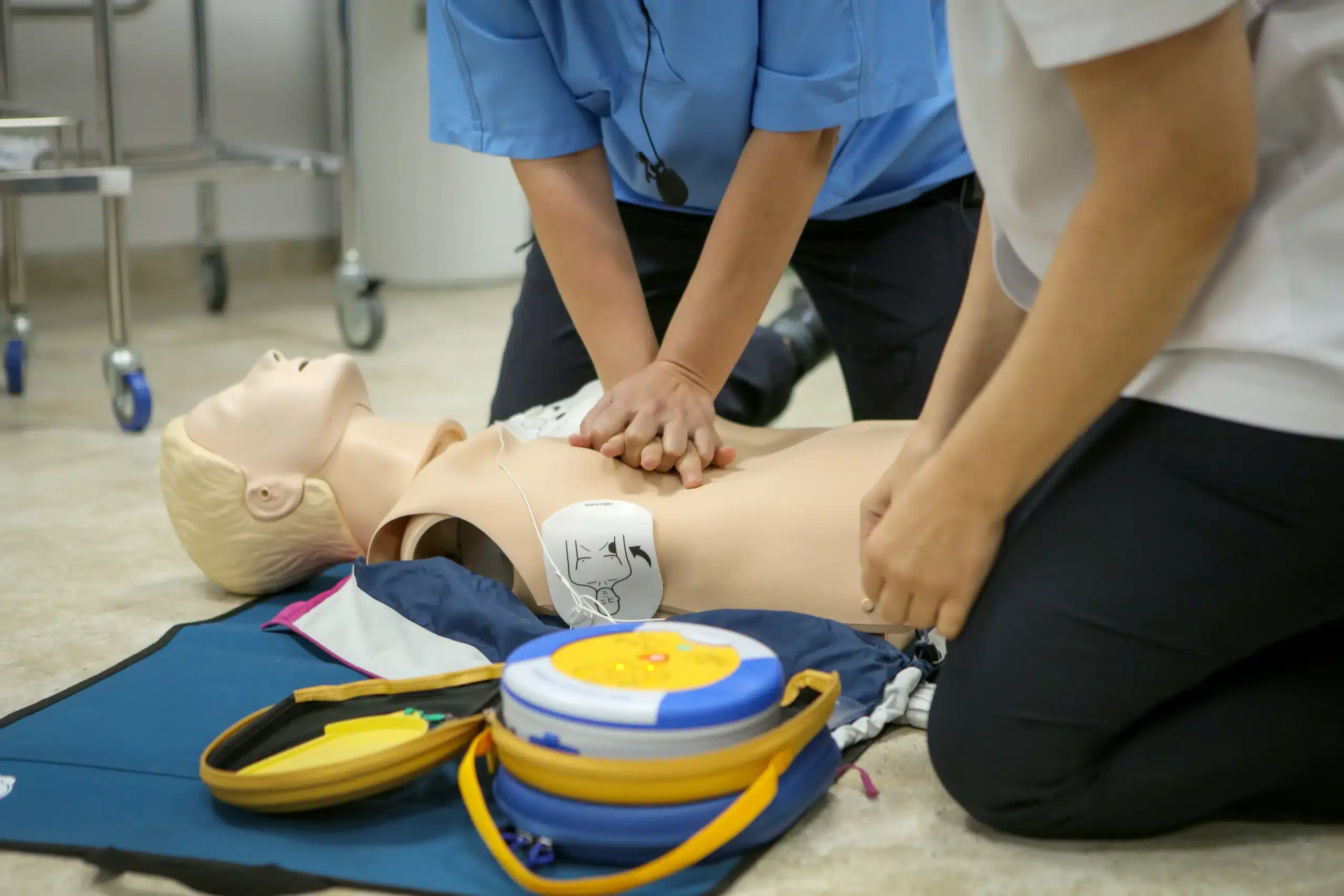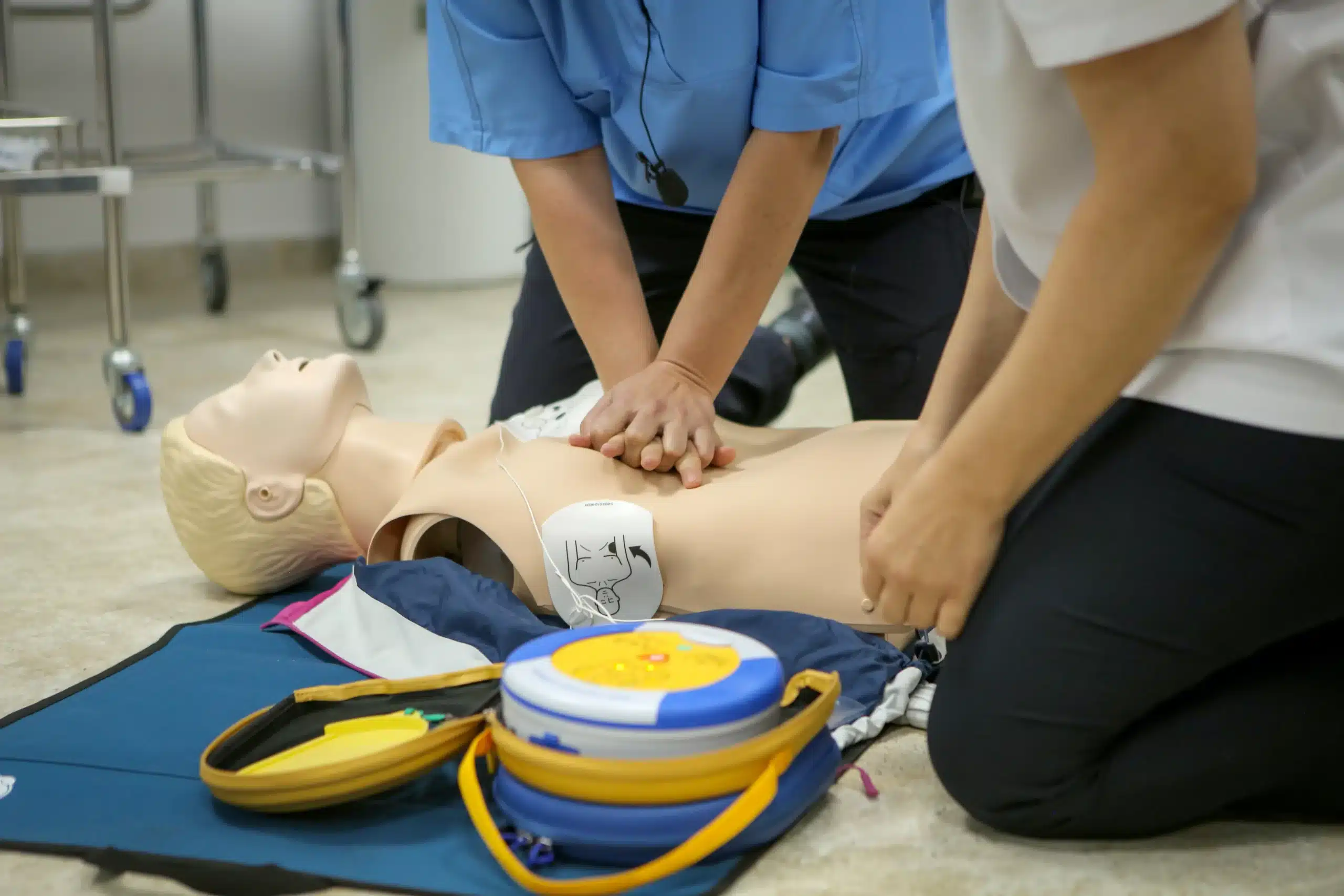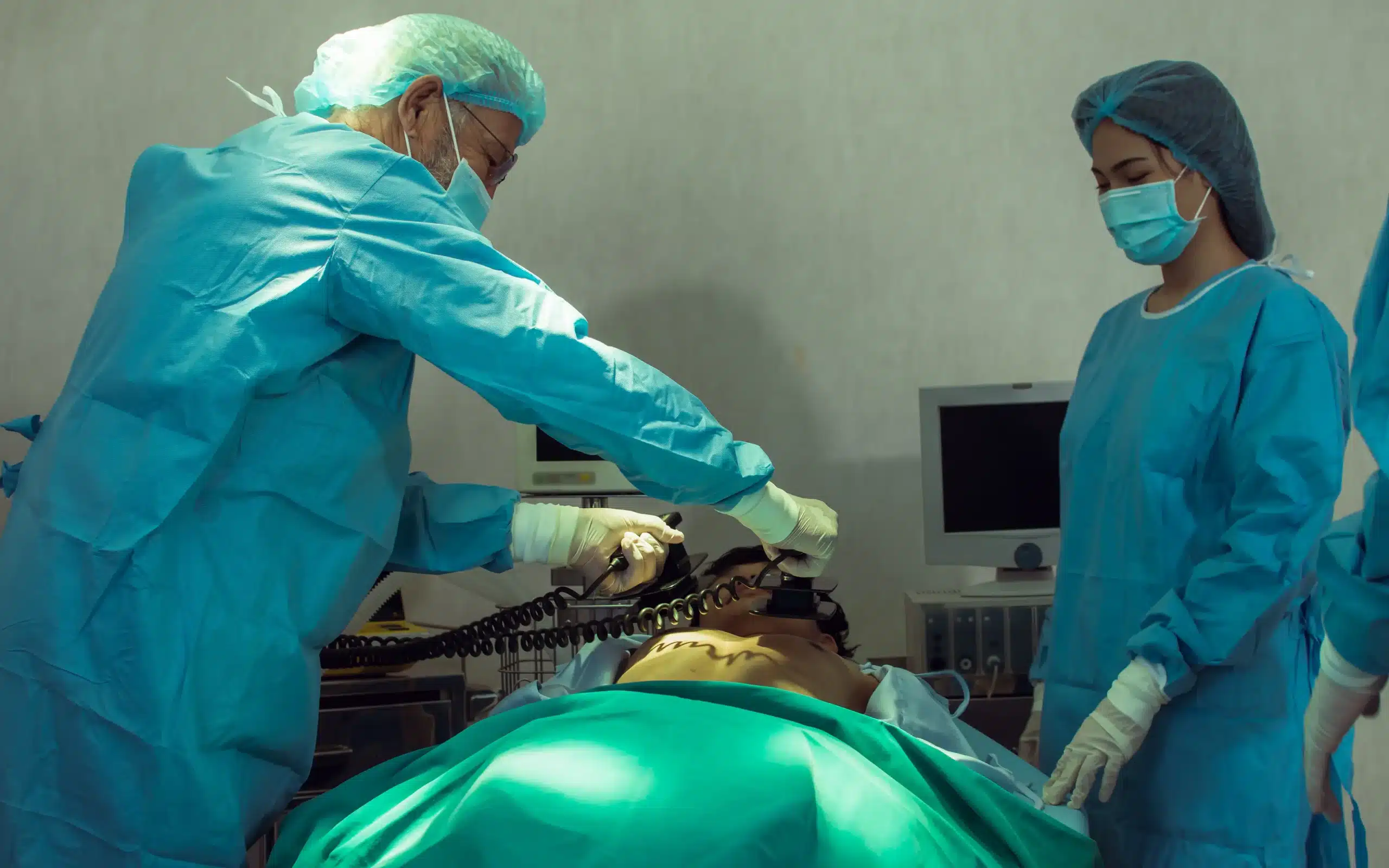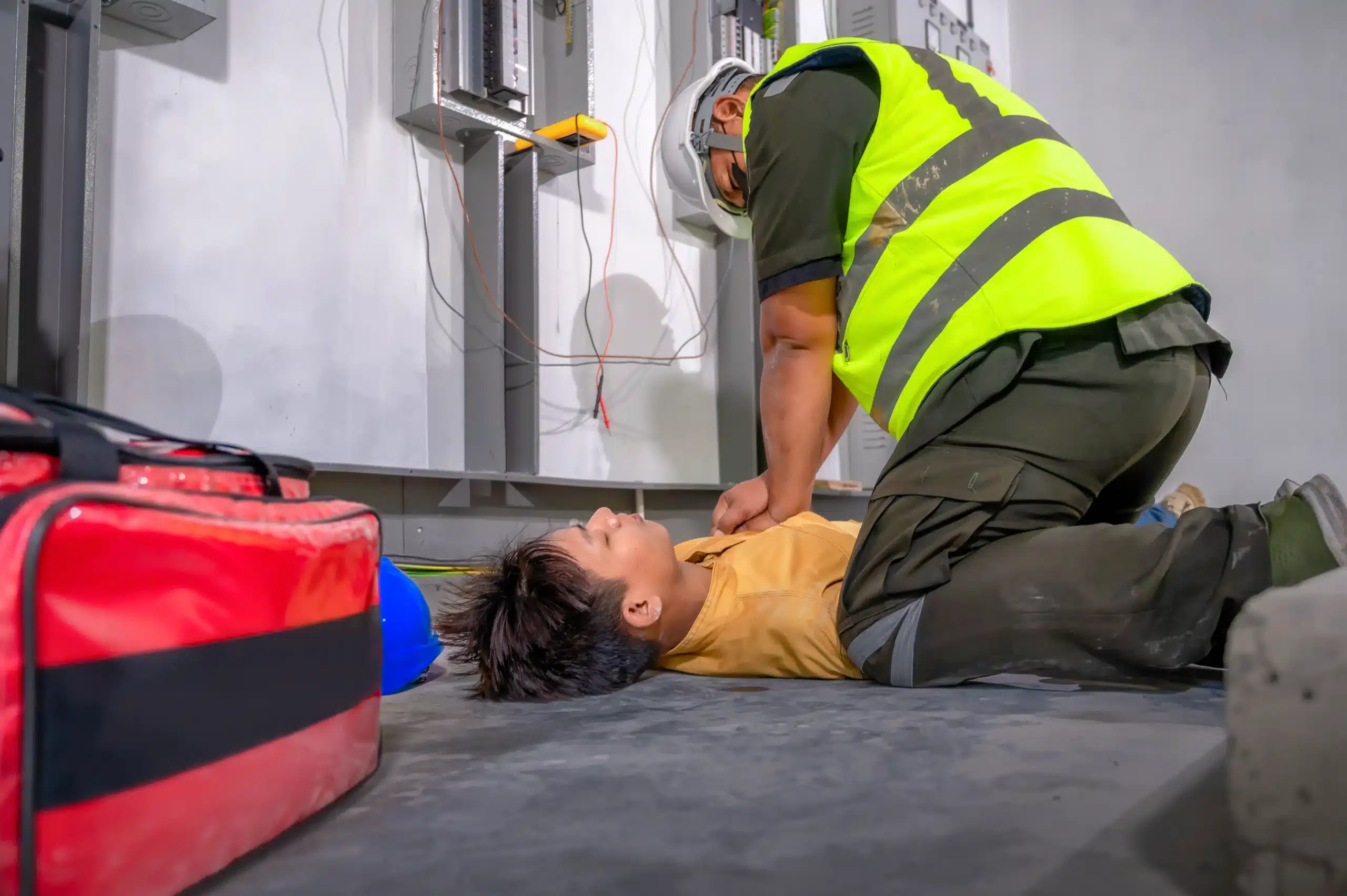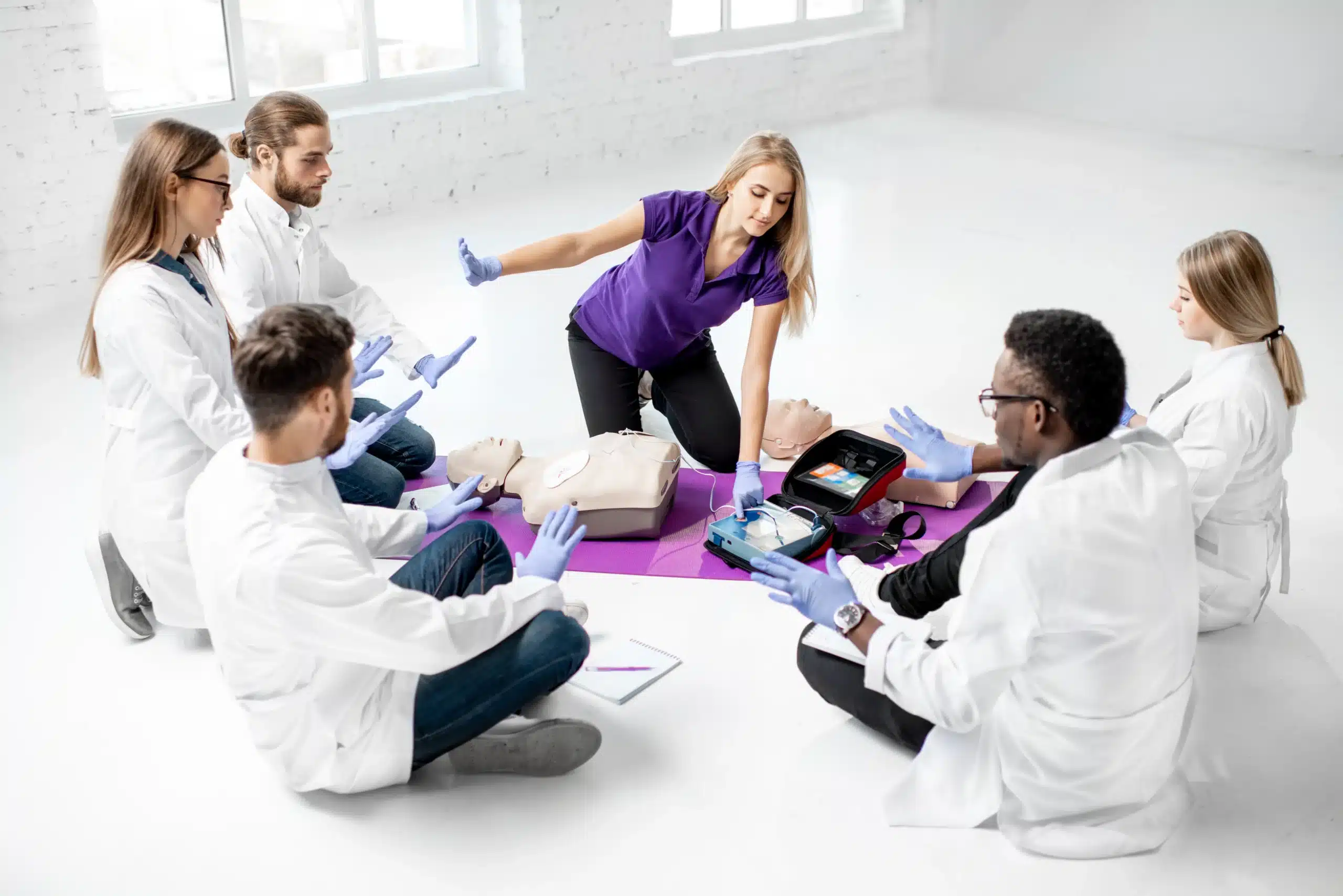Medical emergencies can happen anytime, anywhere. Would you know what to do? CPR training provides the skills and confidence to respond effectively in these critical situations. This article is your go-to resource for everything related to CPR training in Monterey. We’ll cover the basics of CPR, address common misconceptions, and help you choose the right course for your specific needs. We’ll also explore what happens during a typical CPR training session, the benefits of certification, and how to stay up-to-date with the latest techniques. Finally, we’ll discuss the importance of community outreach and how we can work together to promote CPR awareness and create a safer Monterey. Let’s empower ourselves and our community with this life-saving skill.
Key Takeaways
- CPR knowledge empowers you to save lives: From basic CPR to advanced certifications, find a course that fits your individual needs and learn how to respond effectively in emergencies.
- CPR training is accessible and convenient: Explore various resources in Monterey, including online directories and local training centers like Safety Training Seminars, to find a course that suits your schedule and budget.
- Stay current with CPR guidelines: Maintain your certification and skills through renewal courses and continuing education to ensure you’re always prepared to provide effective assistance.
What is CPR and Why Does it Matter?
Learning CPR can empower you to save a life. This section covers the basics of CPR and addresses common misconceptions that might prevent people from acting in a medical emergency.
What is CPR and why is it crucial?
CPR (Cardiopulmonary Resuscitation) is a life-saving technique used when someone’s heart stops beating. It involves chest compressions and rescue breaths to circulate oxygenated blood to the brain and other vital organs. Learning CPR equips you to respond effectively during emergencies and potentially save a life. Every minute without CPR decreases the chances of survival, with brain damage possibly starting after just four minutes. This underscores the critical importance of knowing CPR. CPR training provides the skills and confidence to act quickly and make a real difference when it matters most.
Common CPR Misconceptions
Several myths surround CPR, and it’s important to debunk them. One common misconception is that CPR alone can restart a heart. While CPR maintains blood flow, it buys time until professional medical help arrives. Another myth suggests that performing CPR could cause serious harm. The truth is, the risks of inaction are far greater than the potential for causing minor injuries during CPR. Some also believe that CPR is only for medical professionals. This isn’t true. Anyone can and should learn CPR, empowering themselves to help in a medical emergency. Contact us to learn more about CPR classes. Dispelling these myths is crucial for encouraging wider CPR training and ensuring people feel confident using this life-saving skill. Don’t let these misconceptions hold you back from learning a skill that could save someone’s life.
CPR Training in Monterey: Which Course is Right for You?
Choosing the right CPR course can feel overwhelming, but it doesn’t have to be. Think about who you’ll likely be using these skills on—adults, children, infants, or all of the above—and whether you need certification for personal knowledge or professional reasons. This will guide you toward the best fit. We offer a variety of CPR certification courses to meet your specific needs.
Adult, Child, and Infant CPR
For a well-rounded understanding of CPR, a course covering adult, child, and infant CPR is essential. These comprehensive courses equip you to handle emergencies involving people of all ages. This is especially important for parents, caregivers, teachers, and anyone regularly around children or infants. Knowing how to respond in these critical situations can truly make a difference. Contact us to learn more about our comprehensive CPR training options.
AED and First Aid Training
CPR training often goes hand-in-hand with AED (Automated External Defibrillator) and First Aid training. AEDs are life-saving devices used during cardiac arrest, and knowing how to use one can significantly increase the chances of survival. Many organizations, like Montage Health, offer AED training. Adding First Aid training to your CPR certification provides a broader skill set for handling various medical emergencies, from minor cuts and burns to more serious injuries. Our CPR courses often include AED and First Aid training for a more complete approach to emergency preparedness.
Specialized Courses for Healthcare Professionals
Healthcare providers, such as doctors, nurses, and EMTs, often require more advanced, specialized CPR training. These courses delve deeper into patient care and may include specific protocols and techniques relevant to their professional setting. Some organizations, like Elevate Services, offer tailored CPR courses for specific professions. This specialized training ensures healthcare professionals have the advanced skills and confidence to provide effective care in high-pressure situations. Research emphasizes the importance of detailed feedback during training for healthcare practitioners to refine their techniques and improve the overall quality of CPR they deliver. Our American Heart Association certification courses meet the rigorous standards required for healthcare professionals.
Find and Register for CPR Training in Monterey
So, you’re ready to learn CPR? Great! Finding the right course in Monterey is easier than you think. This section breaks down where to look, how to choose the best class for your needs, and what to expect during the registration process.
Where to find CPR courses
Monterey offers a variety of CPR training options. A good starting point is the American Heart Association’s local guide. They often host training sessions and workshops. Another helpful resource is 211 Monterey County, which offers a free database of health and social services, including referrals to CPR instruction. Montage Health also lists local organizations offering American Heart Association Heartsaver CPR and AED certification. For those affiliated with California State University, Monterey Bay (CSUMB), check their on-campus CPR and AED training programs. And, for convenient, high-quality CPR training in the Monterey area, consider Safety Training Seminars.
Choosing the right course
Not all CPR courses are the same. It’s important to select one that aligns with your needs. The AHA Heartsaver CPR AED course is an excellent option for people with little or no medical background. If you work in education, Elevate Services offers CPR/AED/First Aid training designed for school employees and coaches. Healthcare providers seeking certification or recertification in BLS, ACLS, or PALS should explore the courses offered by Safety Training Seminars. We offer a range of courses to meet the specific requirements of healthcare professionals.
Registration and costs
Registration processes and costs differ depending on the provider. Some organizations, like CSUMB, open registration roughly 19 days in advance and use a waitlist. Check with your chosen provider for their specific policies. CSUMB classes have a 12-person limit; while they may accept walk-ins, those individuals are usually responsible for a $25 upfront fee. Contacting the training center directly, whether it’s Safety Training Seminars or another provider, is always the best way to get accurate information on pricing, scheduling, and registration.
What Happens During CPR Training?
Wondering what to expect in a CPR class? CPR training blends classroom learning with hands-on practice to equip you with the skills and confidence to act in an emergency. Here’s a glimpse into a typical
Course structure and duration
CPR courses typically follow a structured format led by certified instructors. Expect a combination of lectures, demonstrations, and interactive discussions covering essential concepts and techniques. Courses like the American Heart Association Heartsaver CPR AED course are designed for people with little or no medical training. While course duration can vary, many programs, such as the one offered at CSUMB, run for about four hours. This timeframe allows adequate time to cover the material and provides ample opportunity for hands-on practice.
Skills and techniques you’ll learn
CPR training covers a range of life-saving skills. You’ll learn how to recognize the signs of a cardiac arrest and activate the emergency response system. The core of the training focuses on performing chest compressions and rescue breaths—techniques crucial for maintaining blood circulation and oxygenation. Many courses, including those at CSUMB, also incorporate AED training. You’ll learn how to assess the situation, safely operate the AED, and integrate its use into the CPR process.
Hands-on practice and assessment
Hands-on practice is a critical part of CPR training. You’ll work with realistic mannequins, providing a safe environment to practice chest compressions, rescue breaths, and AED use. Studies show that using mannequins with immediate feedback significantly improves engagement and learning. This practical experience builds muscle memory and confidence, allowing you to react effectively in a real emergency. Instructors provide guidance and feedback throughout the practice sessions, ensuring you develop the correct techniques. Understanding these feedback mechanisms is key to improving training effectiveness and, ultimately, patient outcomes. While formal assessments vary by course, most programs require demonstrating proficiency to receive certification.
Why Get CPR Certified?
Getting CPR certified isn’t just about acquiring a skill; it’s about empowering yourself and contributing to a safer community. Whether you’re a healthcare professional, a parent, or simply someone who wants to be prepared, CPR certification offers a range of benefits.
Personal Benefits
CPR certification provides you with the confidence and skills to respond effectively in emergencies. Quality training programs, like those offered at Safety Training Seminars, ensure you’re equipped to perform CPR safely and effectively. This knowledge can make a life-saving difference for loved ones or even strangers. Plus, the detailed feedback you receive during training, like our BLS course, helps you hone your technique and improve the overall quality of your CPR, as highlighted by the NCBI. Knowing you can handle a crisis brings peace of mind and empowers you to take action when it matters most.
Community Impact
Learning CPR contributes to a more resilient and prepared community. Community outreach initiatives are key to encouraging public participation in CPR training and spreading awareness. When more people in a community are CPR-trained, it creates a network of potential lifesavers, ready to assist until professional help arrives. This collective preparedness can significantly improve outcomes in emergencies, fostering a safer environment for everyone. As CPR Certification Now points out, creating a CPR-aware neighborhood has a profound impact on community safety and well-being.
Building a Safer Monterey
CPR certification plays a vital role in building a safer Monterey. By engaging the public through awareness campaigns and accessible training options, the impact of CPR education is magnified. Training empowers individuals to respond effectively in critical situations, potentially saving lives and improving patient outcomes. Understanding the feedback mechanisms of CPR performance, as discussed by Health Education Pro, is crucial for improving training effectiveness and ultimately contributing to a safer and more prepared community. Join us at Safety Training Seminars and become part of the network of lifesavers in Monterey. Contact us today to learn more.
Keep Your CPR Certification Current
Knowing how to perform CPR can be truly life-saving, but it’s not a one-and-done deal. Staying current with the latest guidelines and techniques is essential for providing effective assistance in emergencies. This section covers how to maintain your CPR certification and enhance your skills.
Renewal Requirements and Continuing Education
CPR certifications, like those from the American Heart Association, are typically valid for two years. To maintain your certification, you’ll need to complete a renewal course before it expires. This refresher ensures you’re up-to-date with the most effective CPR techniques and any changes in protocols. Think of it like renewing your driver’s license—it keeps your skills sharp and your knowledge current. Check with your certifying organization or a local training center like Safety Training Seminars for specific renewal requirements.
Staying Up-to-Date with Techniques
CPR techniques can evolve based on the latest research and best practices. Staying current is crucial for delivering the most effective care during emergencies. Studies show that real-time feedback during training significantly improves CPR quality. Look for renewal courses that incorporate this type of feedback to hone your skills. Even small adjustments in technique can make a big difference in positive outcomes.
Advanced Training Opportunities
Want to take your skills to the next level? Consider exploring advanced training options. The AHA Heartsaver CPR AED course is a great starting point for those with limited or no medical background. For healthcare professionals, advanced certifications like ACLS (Advanced Cardiovascular Life Support) and PALS (Pediatric Advanced Life Support) provide specialized training for complex emergencies. You can also look for workshops and training sessions in your community to reinforce your skills and contribute to a culture of preparedness. Staying proactive about your CPR education ensures you’re always ready to respond effectively and confidently.
Promote CPR Awareness in Monterey
CPR skills empower individuals to respond effectively during medical emergencies, creating a safer community for everyone. Let’s explore how we can increase CPR awareness and accessibility right here in Monterey.
Overcoming Training Barriers
One of the biggest hurdles to widespread CPR training is accessibility. Many people, especially in less affluent communities, face barriers like cost, scheduling, and simply knowing where to find training. Research highlights how these factors, along with a lack of previous experience with basic life support education, can deter people from seeking training. Safety Training Seminars addresses these challenges by offering a low-price guarantee and convenient class schedules across various locations, making training more attainable for everyone. We also provide clear and accessible information about our courses, helping individuals take that first step toward learning CPR.
Community Outreach and Education
Community outreach plays a vital role in promoting CPR education and empowering individuals to act confidently in emergencies. Effective outreach involves raising awareness about the importance of CPR and educating the public about available training options. Think public demonstrations, workshops in community centers, and partnerships with local organizations. Creating a CPR-aware neighborhood strengthens community bonds and improves overall safety. These community initiatives ensure more people have the skills to respond to emergencies effectively.
CPR Training in Organizations and Schools
Integrating CPR training into organizations and schools is a powerful way to spread lifesaving knowledge. By partnering with schools, businesses, and community groups, we can equip future generations with essential skills and create a more prepared workforce. Educational programs led by experienced professionals can demystify emergency medical care and empower individuals to take action. Regular CPR workshops and training sessions make learning CPR accessible and convenient, fostering a culture of preparedness. Contact Safety Training Seminars to discuss how we can tailor a CPR training program for your specific group.
Related Articles
- Why CPR is the Lifesaving Skill Everyone Should Know
- CPR Certification in Capitola: Your Guide – Santa Cruz CPR Classes
- Debunking CPR Myths for Lifesaving Confidence
- First Aid in Monterey: Be Prepared for Emergencies – Santa Cruz CPR Classes
- American Heart Association Monterey: Your Local Guide – Santa Cruz CPR Classes
Frequently Asked Questions
What if I’m nervous about performing CPR in a real emergency? It’s completely normal to feel apprehensive about using CPR in a real-life situation. That’s why hands-on practice during training is so important. It helps build muscle memory and confidence, allowing you to react more effectively under pressure. Remember, any attempt at CPR is better than none. You’ve got this!
How often do CPR guidelines change, and why is staying updated important? CPR guidelines are updated periodically to reflect the latest scientific research and best practices. Staying current with these changes ensures you’re using the most effective techniques, which can significantly improve outcomes in emergencies. Regularly reviewing updated materials or taking refresher courses will keep your skills sharp.
Beyond CPR, what other life-saving skills should I consider learning? Learning First Aid and how to use an AED (Automated External Defibrillator) are excellent complements to CPR training. These skills equip you to handle a broader range of medical emergencies, from minor injuries to cardiac arrest. Combining CPR, First Aid, and AED training creates a comprehensive skill set for responding to various situations.
Are there online CPR certification options available, and are they as effective as in-person classes? While online resources can be helpful supplements, in-person CPR classes are generally recommended. The hands-on practice and direct feedback from instructors in a classroom setting are invaluable for developing proper technique and confidence. Look for a blended learning approach that combines online modules with in-person skills sessions for the best learning experience.
What’s the best way to find a reputable CPR training provider in my area? Start by checking the American Heart Association website for authorized training centers near you. You can also contact local hospitals, community centers, or fire departments for recommendations. Look for providers with experienced, certified instructors and a curriculum that includes hands-on practice and feedback. Don’t hesitate to ask about their teaching methods and certification process.
